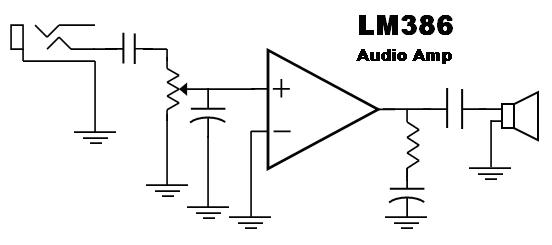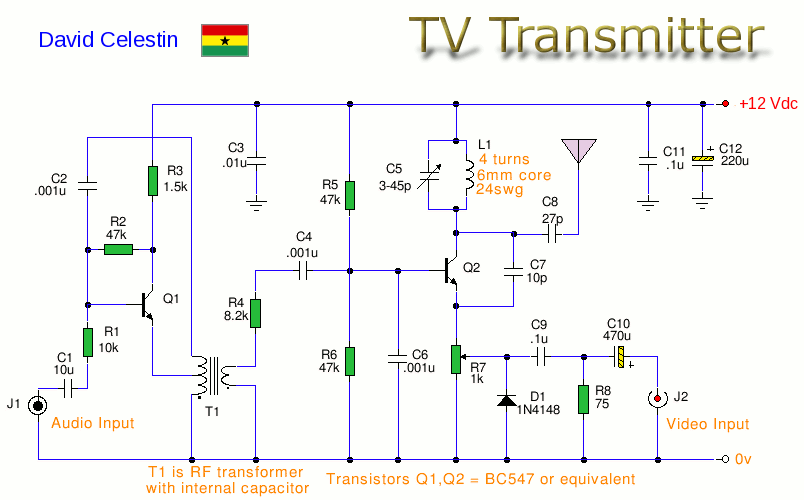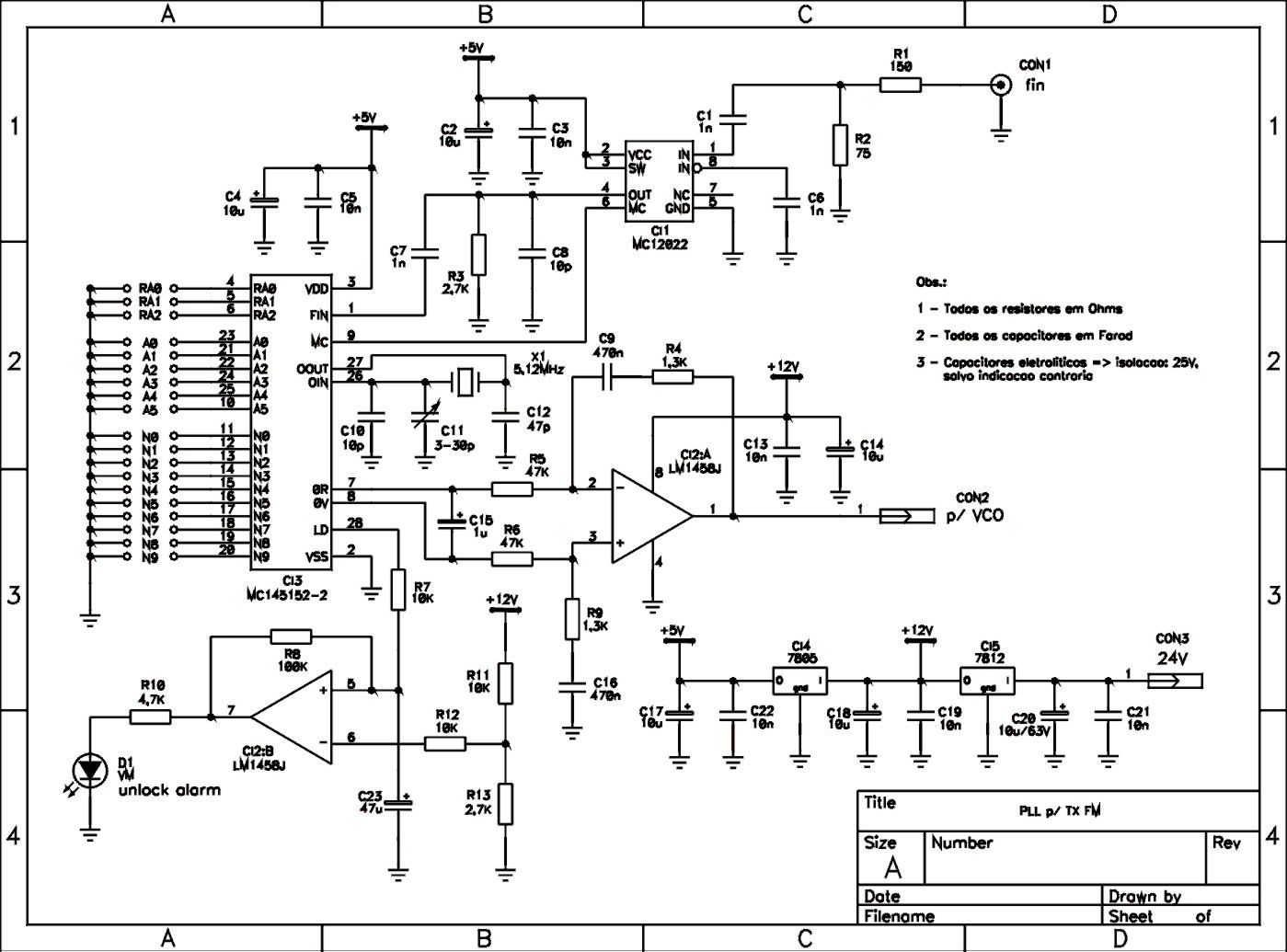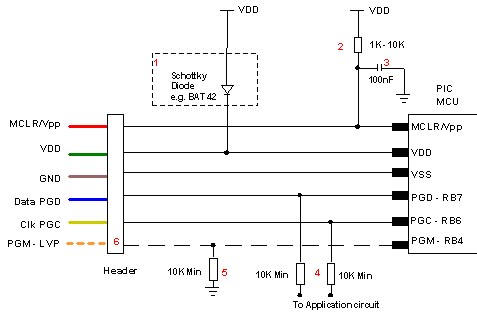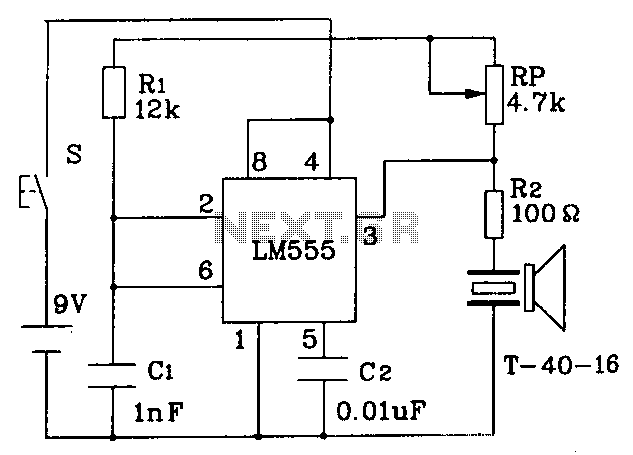
Micro Transmitter Bug
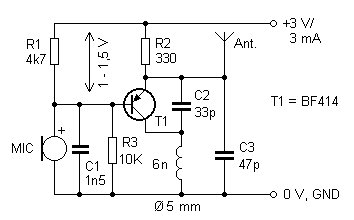
The presented FM transmitter circuit is constructed using BF414, BF324, or BF606 transistors. It features a 30 cm antenna that provides a range of approximately 30 meters indoors and even greater range outdoors. The power supply consists of two AAA batteries, delivering a voltage of 2.75 V. A 10 kΩ resistor is connected in parallel with a 1.5 pF capacitor to ensure optimal performance when interfacing with external audio sources such as an MP3 player or computer. It was necessary to reduce the computer's audio output to around 35% to prevent clipping. Additionally, transmitter stability was enhanced through basic shielding techniques. The coil is composed of five turns of enameled copper wire, wound on a form with a diameter of 5 mm.
The FM transmitter circuit utilizes a common emitter configuration, where the chosen transistor amplifies the audio signal for transmission. The BF414, BF324, and BF606 transistors are suitable for this application due to their high-frequency response and low noise characteristics, making them ideal for FM modulation. The 30 cm antenna is designed to be resonant at the desired frequency of operation, which allows for effective radiating of the modulated signal.
The power supply design, utilizing two AAA batteries, provides a compact and portable power source with a nominal voltage of 2.75 V, ensuring that the circuit operates efficiently without excessive power consumption. The inclusion of the 10 kΩ resistor in parallel with the 1.5 pF capacitor forms a high-pass filter that helps to block low-frequency noise and stabilize the audio signal when connected to external devices.
The requirement to adjust the computer's sound output to 35% capacity is an important consideration for avoiding distortion, particularly in audio applications where signal integrity is paramount. The shielding implemented in the design serves to minimize electromagnetic interference, thereby improving the overall stability and performance of the transmitter.
The coil, consisting of five turns of enameled copper wire with a diameter of 5 mm, is critical for creating the oscillating magnetic field necessary for RF transmission. The inductance of this coil, combined with the capacitance of the circuit, determines the resonant frequency, which is crucial for effective FM broadcasting. Proper tuning of the circuit may be necessary to achieve optimal performance, which can be done by adjusting the coil turns or using variable capacitors in conjunction with the fixed capacitors.
Overall, this FM transmitter design is a practical solution for short-range audio transmission, suitable for various applications such as personal broadcasting or audio demonstrations.Presented FM transmitter bug is built using BF414 / BF324 / BF606 transistor. The 30cm antenna has a range of about 30m in the building, more in the open field. Power supply 2x AAA batteries have been used with voltage of 2.75 V. I added resistor 10K in parallel with 1.5pF capacitor so that the system works well when connected to an external source (mp3 player / computer). On the computer I had to reduce sound to about 35% of capacity, so that I do not have clipping. I managed to improve transmitter stability with simple shielding. The coil is 5 turns of enameled copper wire wound on 1 mm ? = 5 mm 🔗 External reference
The FM transmitter circuit utilizes a common emitter configuration, where the chosen transistor amplifies the audio signal for transmission. The BF414, BF324, and BF606 transistors are suitable for this application due to their high-frequency response and low noise characteristics, making them ideal for FM modulation. The 30 cm antenna is designed to be resonant at the desired frequency of operation, which allows for effective radiating of the modulated signal.
The power supply design, utilizing two AAA batteries, provides a compact and portable power source with a nominal voltage of 2.75 V, ensuring that the circuit operates efficiently without excessive power consumption. The inclusion of the 10 kΩ resistor in parallel with the 1.5 pF capacitor forms a high-pass filter that helps to block low-frequency noise and stabilize the audio signal when connected to external devices.
The requirement to adjust the computer's sound output to 35% capacity is an important consideration for avoiding distortion, particularly in audio applications where signal integrity is paramount. The shielding implemented in the design serves to minimize electromagnetic interference, thereby improving the overall stability and performance of the transmitter.
The coil, consisting of five turns of enameled copper wire with a diameter of 5 mm, is critical for creating the oscillating magnetic field necessary for RF transmission. The inductance of this coil, combined with the capacitance of the circuit, determines the resonant frequency, which is crucial for effective FM broadcasting. Proper tuning of the circuit may be necessary to achieve optimal performance, which can be done by adjusting the coil turns or using variable capacitors in conjunction with the fixed capacitors.
Overall, this FM transmitter design is a practical solution for short-range audio transmission, suitable for various applications such as personal broadcasting or audio demonstrations.Presented FM transmitter bug is built using BF414 / BF324 / BF606 transistor. The 30cm antenna has a range of about 30m in the building, more in the open field. Power supply 2x AAA batteries have been used with voltage of 2.75 V. I added resistor 10K in parallel with 1.5pF capacitor so that the system works well when connected to an external source (mp3 player / computer). On the computer I had to reduce sound to about 35% of capacity, so that I do not have clipping. I managed to improve transmitter stability with simple shielding. The coil is 5 turns of enameled copper wire wound on 1 mm ? = 5 mm 🔗 External reference
